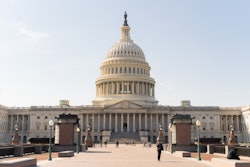Politicians and policymakers are lavishing unprecedented attention on community colleges, promoting them as engines to train workers in the recession and boost the country’s college graduation rates.
Where rhetoric meets reality on campus, you’ll find people like Tania DeLeon, a student at Folsom Lake College in California who can’t get into the classes she wants, must shuttle between two campuses 45 minutes apart and is spending spring break earning a paycheck so she can pay for gas and graduate on time.
Grappling with soaring enrollment and plummeting state support, community colleges are grateful for the higher profile but disappointed money has yet to materialize to help them keep up with demand, let alone meet ambitious Obama administration goals to make the U.S. the global leader in college graduates again by 2020.
“It’s a difficult, challenging time for us,” said George Boggs, president and CEO of the American Association of Community Colleges. “But in the longer term view, we’ve never seen the image of community colleges as high as it is right now. Overall, I’m optimistic for the future.”
No longer the afterthought of higher education, the nation’s 1,200 community, technical and junior colleges enroll more than 6 million students – almost half the nation’s college population. Public colleges’ open-door policies and low fees draw many low-income, first-generation, immigrant and Hispanic students.
The economic downturn has pressured both schools and their students, most of whom work long hours. Sinking tax revenues at state and local levels have forced public colleges to cut courses or schedule them around the clock, slash summer sessions, eliminate academic programs and even restrict enrollment.
In Detroit, record demand prompted the Wayne County Community College District to cap student enrollment this spring for the first time in its 40-year history. Louisiana’s community and technical colleges, facing a 4.5 percent state budget cut, have slashed 100 academic programs in the past year.
A survey of 128 community college systems released last week found that 52 percent reported reductions in their operating budgets this year, a slight improvement over last year’s grim numbers. But those facing cuts face steeper ones: the number of campuses with cuts exceeding 10 percent more than doubled.
The crunch leaves little money for remedial education reform, counseling to better prepare students for college’s challenges and other innovations to improve completion rates. Just 35 percent of community college entrants earn a certificate or an associate or bachelor’s degree within six years, estimates say.
“You put all these factors together, it’s sort of a perfect storm,” said Dr. Michael Kirst, professor emeritus of education and business administration at Stanford University. “One would predict our graduation rates will decline, not increase, from the community colleges. We’ll move backwards.”
Consider the challenges facing DeLeon, who like many community college students is trying to become the first in her family to graduate college.
When she started at Folsom Lake College outside Sacramento in 2007, DeLeon had no problem finding courses. She finished school by mid-day and went to work. Then the budget crisis struck California.
“Now I’m taking a class that ends at 10 o’clock at night,” she said.
DeLeon commuted between two different campuses in the Los Rios Community College system – California’s second largest – to get courses she need to finish in time. She persevered: DeLeon will graduate in May and transfer to California State University, Sacramento to pursue a career in juvenile justice.
The picture is even bleaker for some schools that rely on local as well as state tax dollars.
Montgomery College in Maryland, renowned for its engineering program, is facing a proposed 12 percent cut in county money and $14.5 million less than it requested – the cost of operating one of its three campuses.
“Everyone talks about jobs, jobs, jobs,” interim president Hercules Pinkney said. “Well, we’re the ones training the work force. Hopefully that argument will win the day.”
The timing couldn’t be worse coming off a record fall enrollment of 26,000, state budget cuts and proposed tuition increases. Nursing student Brenique Lewis devised a strategy for the class crunch: she waits until just before classes start and snatches up vacancies left by students who don’t pay and get dropped.
“I was lucky,” said Lewis, 19, a recent immigrant from Jamaica who works part time at a car dealership. “If tuition increases, if there are more cuts, more people are going to drop out.”
Community colleges’ latest lesson in economic and political realities came last week, when President Barack Obama signed legislation overhauling the federal student loan program.
The law, a centerpiece of Obama’s education agenda, strips banks of their role as middlemen in the loan business and puts the government in charge, saving an estimated $61 million over 10 years.
The House version approved last fall called for community colleges to receive $10 billion to help fulfill the White House’s American Graduation Initiative, providing an infusion of federal cash for job training, building projects and initiatives to get more students out the door with degrees or certificates.
But because the projected savings from axing the bank subsidies were less than anticipated, community colleges instead will only get $2 billion for job training alone.
Most of the money from the overhaul will go to expand the maximum size of Pell grants for needy students, and additional money set aside for Hispanic-serving institutions also will benefit community colleges.
Dr. Will Holcombe, chancellor of the Florida College System, echoed many of his colleagues by saying he’s happy to come away with something but disappointed in the scaled-down vision.
“Federal money and grant money, it seems, are about the only two vehicles we have for innovation these days,” Holcombe said. “Our states are struggling to provide us with just the basic funding.”
Frank Chong, the U.S. Department of Education’s deputy assistant secretary for community colleges, said the $2 billion is “something of a down payment” on the graduation initiative.
“We need to use those funds to move the cause forward,” said Chong, former president of Laney College, the flagship of California’s Peralta Community College District. “We know our work is not done yet.”
Given the economic climate, community colleges’ role in job development is rightly the top priority, said Jamie Merisotis, president of the Indianapolis-based Lumina Foundation for Education, one of several foundations that have invested heavily in community colleges and boosted their profile.
Merisotis and others are pushing for accelerated programs to get students through community colleges faster, which would both improve graduation rates and ease space pressures. But, he said, that would require colleges to find money to realign curriculum and give stipends to students so they don’t work so much.
For now, community colleges are doing what they’ve always done – more with less.
One case in point is Northern Virginia Community College, the setting for Obama’s student loan bill-signing ceremony. (The White House also used the opportunity to announce that Dr. Jill Biden, the vice president’s wife and an instructor at the college, will convene a summit on community colleges this fall).
The Virginia school has experienced a 23 percent cut in state funding and 24 percent enrollment growth in the past three years. Yet it has expanded online offerings to better combine e-learning with classroom instruction and used its world language program to attract international students who pay higher tuition.
“A significant portion of higher education is hunkered down, trying to wait out the storm,” said college President Robert Templin. “We’ve taken the approach that while things will get better, they will never get back to the way they were. We’re going to have to find new ways to do our work.”















